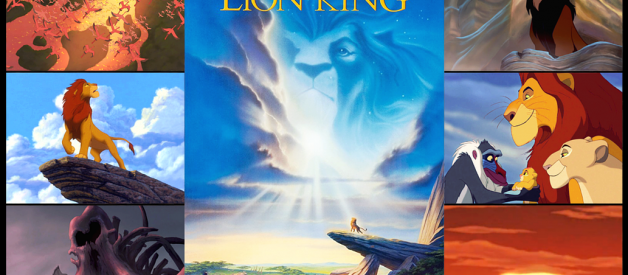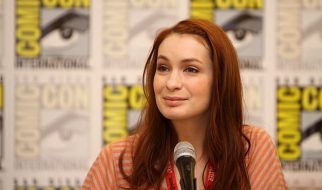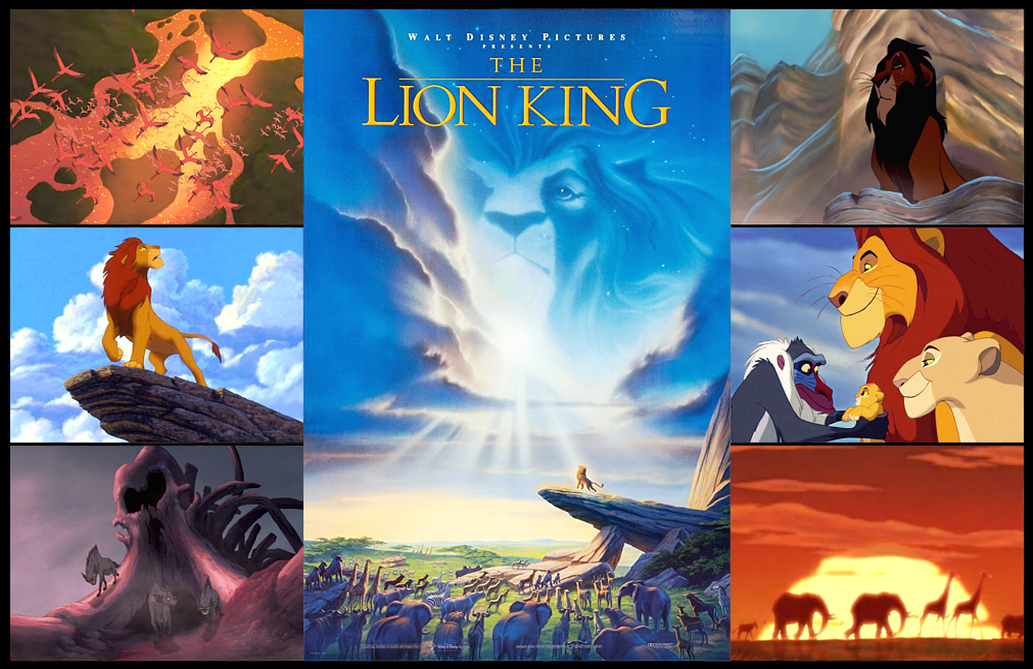 Photograph of film poster with a display of scene images from ?The Lion King?.
Photograph of film poster with a display of scene images from ?The Lion King?.
Before I get into this, I want to make mention ?A FILM TO REMEMBER? will be a series about films that have reached a milestone anniversary since their origin in being culturally, historically, or aesthetically significant. The articles will contain the film?s plot outline, director, cast, a compilation of trivialities, various photos, movie trailer, critical reception and more. So, let?s start:
We are here to mark the celebration of the 25th Anniversary of Roger Allers and Rob Minkoff?s ?The Lion King?. Let?s take an inside look at the film:
PLOT OUTLINE:
A Lion cub crown prince is tricked by a treacherous uncle into thinking he caused his father?s death and flees into exile in despair, only to learn in adulthood his identity and his responsibilities.
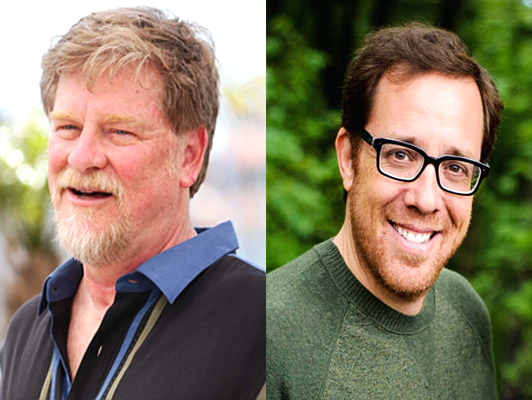 Still image of filmmakers Roger Allers (left) and Rob Minkoff (right).
Still image of filmmakers Roger Allers (left) and Rob Minkoff (right).
STUDIO:
Walt Disney Pictures
DIRECTOR:
Roger Allers and Rob Minkoff
CAST:
Jonathan Taylor Thomas ? Young Simba (voice)
Matthew Broderick ? Simba (voice)
James Earl Jones ? Mufasa (voice)
Jeremy Irons ? Scar (voice)
Rowan Atkinson ? Zazu (voice)
Niketa Calame-Harris ? Young Nala (voice)
Moira Kelly ? Nala (voice)
Nathan Lane ? Timon (voice)
Ernie Sabella ? Pumbaa (voice)
Whoopi Goldberg ? Shenzi (voice)
Jim Cummings ? Ed (voice)
Cheech Marin ? Banzai (voice)
Robert Guillaume ? Rafiki (voice)
Zoe Leader ? Sarafina (voice)
Madge Sinclair ? Sarabi (voice)
Frank Welker ? Lion Roars (voice)
Cathy Cavadini ? Additional Voice (voice)
Judi M. Durand ? Additional Voice (voice)
Daamen J. Krall ? Additional Voice (voice)
David McCharen ? Additional Voice (voice)
Mary Linda Phillips ? Additional Voice (voice)
Phil Proctor ? Additional Voice (voice)
David J. Randolph ? Additional Voice (voice)
GENRE(S):
Animation | Adventure | Drama | Family | Musical
TAGLINE:
The greatest adventure of all is finding our place in the circle of life.
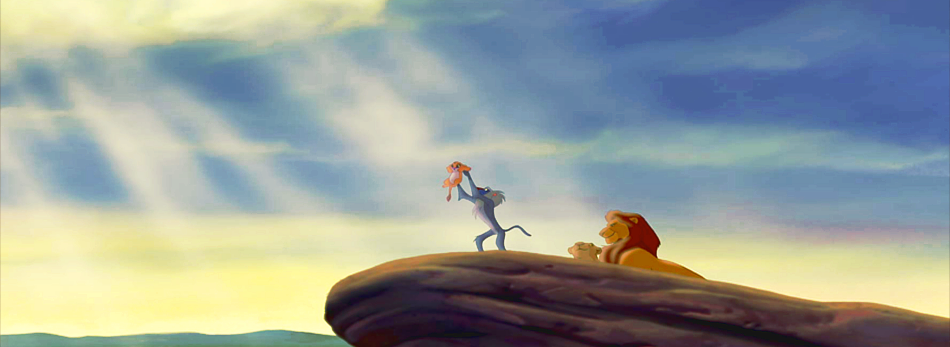 Still image of characters Simba (being held), Rafiki, Mufasa and Sarabi in ?The Lion King?.
Still image of characters Simba (being held), Rafiki, Mufasa and Sarabi in ?The Lion King?.
The film is known for being the typification of the last heyday of classic feature cel animation that existed in the 1990s during the Disney Renaissance, this was the first Disney animated film to be an original story, rather than be based on an existing work, as it was inspired by the lives of Joseph and Moses from the Bible, and William Shakespeare?s Hamlet. Co-Directors Roger Allers and Rob Minkoff visually blend hand drawn animation with elements of computer generated animation, particularly, the ?wildebeest stampede? sequence, as its all anchored together with a strong dose of emotional and dramatic resonance that?s driven by its jaunty musical tunes onward with a superb fervor in this emotionally stirring, richly majestic, humorously witty and a charmingly entertaining achievement of a cinematic animated touchstone. The film is based from an original idea by Jeffrey Katzenberg, Roy E. Disney and Peter Schneider, it received wide acclaim but not without some critical remarks and controversial regards but it has since went on to reaching the pantheon of being the last traditional animated quintessential classic in its genre and of the Disney Renaissance era.
Here?s what some of the critical receptions have been for the film over the years:
Owen Gleiberman from Entertainment Weekly says: ??The Lion King,? more than any of the recent wave of Disney animated features, has the resonance to stand not just as a terrific cartoon but as an emotionally pungent movie.?
Desmond Ryan from Philadelphia Inquirer says: ??The Lion King,? complete with jaunty songs by Elton John and Tim Rice, is undeniably and fully worthy of its glorious Disney heritage. It is a gorgeous triumph ? one lion in which the studio can take justified pride.?
Terrence Rafferty from The New Yorker says: ?Between traumas, the movie serves up soothingly banal musical numbers [composed by Elton John and Tim Rice] and silly, rambunctious comedy.?
Gene Siskel from Chicago Tribune says: ?It bears repeating that, ?The Lion King? is quite entertaining as children?s fare goes these days. But Disney has established a standard so high on animated features that anything less than a classic leaves you feeling that something?s missing.?
John Hartl from Seattle Times says: ?It?s perhaps the closest Disney has come to creating a consciously mythical entertainment in the style of ?Star Wars?. Yet like that film it keeps its sense of humor and fun.?
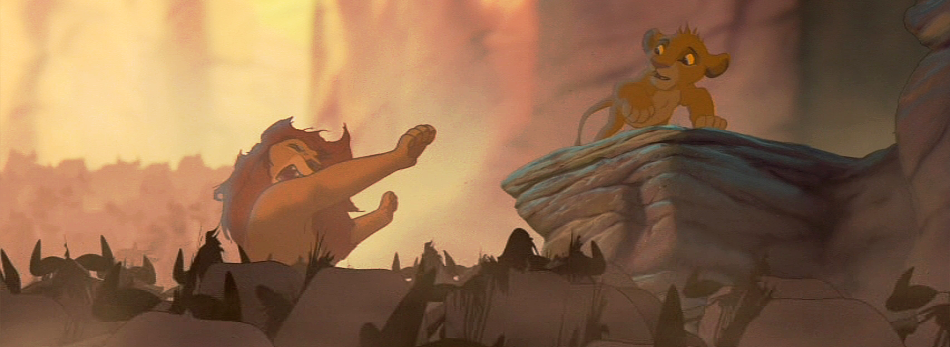 Still image of the characters Mufasa and Simba in ?The Lion King?.
Still image of the characters Mufasa and Simba in ?The Lion King?.
As you can tell by the critical reactions, the film captured critical praise overall but had denunciations with some pundits solicit it?s loaded with hoary biblical and Shakespearean references and less savory qualities, but furthermore had various controversial matters pertaining to plagiarism, protest of the hyenas? portrayal and representing an anti-immigrant allegory, and lastly, advancing a ?fascist narrative? in its portrayal of the lion kingdom and the circle of life. Nevertheless, there is real enthusiasm in its narrative, a prompt, at times brutal tale of dynastic hindrance in the animal kingdom, as Allers and Minkoff intersperse between grand opera dramatics and low-comedy hi-jinks, supremely blending the duality approaches through illustrious musical numbers and its soulful message of personal growth and evolution in this wondrously imaginative, vividly breathtaking, surprisingly dark, high-spirited comicality and a visually immersive animated benchmark. But I?ll let you decide?
So, to get a better look at the film, here?s a link to the movie trailer of Roger Allers and Rob Minkoff?s ?The Lion King?:
Here I have provided 12 interesting and intriguing trivia facts (I wanted to keep it limited) about ?The Lion King?:
- The idea for film was conceived in late 1988 during a conversation between producer and executive Jeffrey Katzenberg, senior executive Roy E. Disney and producer Peter Schneider on a plane to Europe to promote ?Oliver & Company? (1988). During the conversation, the topic of a story set in Africa came up, and Katzenberg immediately jumped at the idea. The idea was then developed by Walt Disney Feature Animation?s vice president for creative affairs Charlie Fink. Katzenberg decided to add elements involving coming-of-age-and-death, and notions from personal life experiences, such as some of his trials in his bumpy road in politics, saying about the film, ?It is a little bit about myself.? In November of that year, Thomas Disch (author of ?The Brave Little Toaster?) wrote a treatment entitled ?King of the Kalahari,? and afterwards, screenwriter Linda Woolverton spent a year writing drafts of the script, which was titled ?King of the Beasts? and then ?King of the Jungle.? The original version of the film was very different from the final film with the plot centered on a battle being between lions and baboons with the character of Scar (voiced by Jeremy Irons) as the leader of the baboons and the character of young Simba (voiced by Jonathan Taylor Thomas) staying in the kingdom but becomes a ?lazy, slovenly, horrible character? due to manipulations from Scar, and could be overthrown after coming-of-age.
- By 1990, producer Thomas Schumacher, who had just completed ?The Rescuers Down Under? (1990) decided to attach himself to the project ?because lions are cool?. Schumacher likened the script for ?King of the Jungle? to ?an animated National Geographic special?. ?Oliver & Company? filmmaker George Scribner was the initial director of the film, being later joined by co-director Roger Allers, who was the lead story man on ?Beauty and the Beast? (1991). Allers brought with him screenwriter Brenda Chapman, who would become the head of story. Afterwards, several of the lead crew members, including Allers, Scribner, Schumacher, Chapman and production designer Chris Sanders, took a trip to Hell?s Gate National Park in Kenya, in order to study and gain an appreciation of the environment for the film.
- After 6 months of story development work George Scribner decided to leave the project, after clashing with Allers and the producers on their decision to turn the film into a musical, as Scribner?s intention was of making a documentary-like film more focused on natural aspects. Co-director Rob Minkoff replaced Scribner, and producer Don Hahn joined the production as Thomas Schumacher became only an executive producer due to Disney promoting him to Vice President of Development for Feature Animation. Hahn found the script unfocused and lacking a clear theme, and after establishing the main theme as ?leaving childhood and facing up to the realities of the world,? asked for a final retool. Allers, Minkoff, Chapman and Hahn then rewrote the story across 2 weeks of meetings with filmmakers Kirk Wise and Gary Trousdale, who had just finished ?Beauty and the Beast?. The script also had its title changed from ?King of the Jungle? to ?The Lion King,? as the setting was not the jungle but the savannah. It was also decided to make the characters of Scar and Mufasa (voiced by James Earl Jones) brothers since the writers felt that it was much more interesting if the threat came from someone within the family.
- During the summer of 1992, the team was joined by screenwriter Irene Mecchi, with a second screenwriter, Jonathan Roberts, joining a few months later. Mecchi and Roberts took charge of the revision process, fixing unresolved emotional issues in the script and adding comicality for the characters of Timon (voiced by Nathan Lane) and Pumbaa (voiced by Ernie Sabella), and the 3 hyenas (voiced by Whoopi Goldberg, Jim Cummings and Cheech Marin). Lyricist Tim Rice worked closely with the writing team, flying to California at least once a month because his songs needed to work in the narrative continuity. Rice?s lyrics ? which were reworked up to the production?s end ? were pinned to the storyboards during development. Rewrites were frequent, with animator Andreas Deja saying that completed scenes would be delivered, only for the response to be that parts needed to be reanimated because of dialog changes.
- The development of the film coincided with ?Pocahontas? (1995), which most of the Disney animators decided to work on instead, believing it would be the more prestigious and successful of the 2 films. The story artists also did not have much faith in the project, with Brenda Chapman declaring she was reluctant to accept the job ?because the story wasn?t very good,? and storyboarder Burny Mattinson saying to co-worker Joe Ranft ?I don?t know who is going to want to watch that one.? Most of the leading animators either were doing their first major work supervising a character, or had much interest in animating an animal. These 13 supervising animators, both in California and in Florida, were responsible for establishing the personalities and setting the tone for the film?s main characters. Nearly 20 minutes of the film, including the ?I Just Can?t Wait to Be King? sequence, were animated at the Disney?s MGM Studios theme park in Orlando, Florida. More than 600 artists, animators and technicians contributed to the film.
- Just weeks before the film was to be released, the 1994 Northridge earthquake shut down the studio production in California and required the animators to finish their work from home.
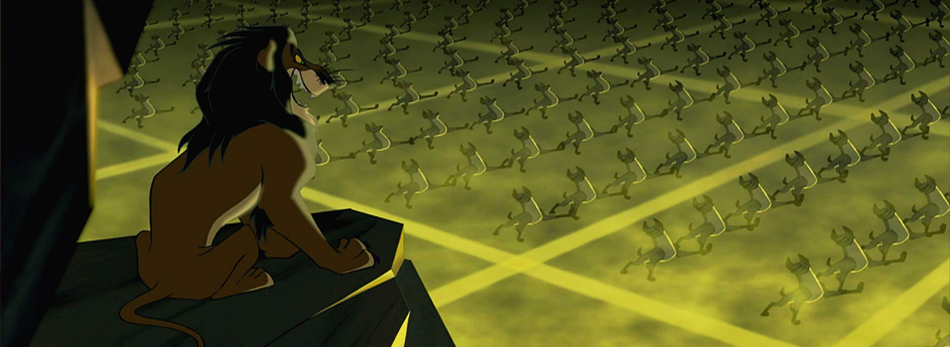 Still image of the character Scar in ?The Lion King?.
Still image of the character Scar in ?The Lion King?.
- The character animators studied real-life animals for reference, as was done for the Disney film ?Bambi? (1942). Jim Fowler, renowned wildlife expert, visited the studios on several occasions with an assortment of lions and other savannah inhabitants to discuss behavior and help the animators give their drawings authenticity. The animators also studied animal movements at the Miami MetroZoo under guidance from wildlife expert Ron Magill. The Pride Lands are modeled on the Kenyan national park visited by the crew. Varied focal lengths and lenses were employed to differ from the habitual portrayal of Africa in documentaries ? which employ telephoto lenses to shoot the wildlife from a distance.
- The epic feel drew inspiration from concept studies by artist Hans Bacher ? which, following George Scribner?s request for realism, tried to depict effects such as lens flare ? and the works of painters Charles Marion Russell, Frederic Remington and Maxfield Parrish. Art director Andy Gaskill and the filmmakers sought to give the film a sense of grand sweep and epic scale similar to ?Lawrence of Arabia? (1962). Gaskill explained: ?We wanted audiences to sense the vastness of the savannah and to feel the dust and the breeze swaying through the grass. In other words, to get a real sense of nature and to feel as if they were there. It?s very difficult to capture something as subtle as a sunrise or rain falling on a pond, but those are the kinds of images that we tried to get.?
- Because the characters were not anthropomorphized, all the animators had to learn to draw four-legged animals, and the story and character development was done through use of longer shots following the characters. Computers helped the filmmakers present their vision in new ways. For the ?wildebeest stampede? sequence, several distinct wildebeest characters were created in a 3D computer program, multiplied into hundreds, cel shaded to look like drawn animation, and given randomized paths down a mountainside to simulate the real, unpredictable movement of a herd. There was 5 specially trained animators and technicians spent more than 2 years creating the two-and-a-half-minute stampede. The CAPS (Computer Animation Production System) helped simulate camera movements such as tracking shots, and was employed in coloring, lighting and particle effects.
- Lyricist Tim Rice, who was working with composer Alan Menken on songs for ?Aladdin? (1992), was invited to write the songs, and accepted on the condition of finding a composing partner. As Menken was unavailable, the producers accepted Rice?s suggestion of singer and songwriter Elton John, after Rice?s invitation of ABBA fell through due to Benny Andersson being busy with the musical ?Kristina frn Duvemla.? John expressed an interest in writing, mentioning a possible influence of ?The Jungle Book? (1967), where he felt the ?music was so funny and appealed to kids and adults?. John and Rice wrote 5 original songs for the film (?Circle of Life,? ?I Just Can?t Wait to Be King,? ?Be Prepared,? ?Hakuna Matata? and ?Can You Feel the Love Tonight?), with John?s vocal of ?Can You Feel the Love Tonight? playing over the end credits. The score was composed by Hans Zimmer, who was hired based on his work in 2 films in African settings, ?A World Apart? (1988) and ?The Power of One? (1992), and supplemented the score with traditional African music and choir elements arranged by Lebo M. Zimmer?s partners Mark Mancina and Jay Rifkin helped with arrangements and song production.
- For the film?s first movie trailer, Walt Disney Studios opted to feature a single scene, the entire opening sequence with the song ?Circle of Life?. Buena Vista Pictures Distribution president Dick Cook said the decision was made for such an approach because ?we were all so taken by the beauty and majesty of this piece that we felt like it was probably one of the best four minutes of film that we?ve seen?, and Don Hahn added that ?Circle of Life? worked as a trailer as it ?came off so strong, and so good, and ended with such a bang.? The trailer was released in November 1993, accompanying ?The Three Musketeers? (1993) and ?Sister Act 2: Back in the Habit? (1993) in theaters; by then, only a third of film had been completed. Audience reaction was enthusiastic, causing Hahn to have some initial concerns as he became afraid of not living up to the expectations raised by the preview. Prior to the film?s release, Disney did 11 test screenings.
- The film faced a number of various controversies that included: Certain elements of the film were considered to bear a resemblance to Osamu Tezuka?s Japanese anime television series, ?Jungle Emperor? (1965?1967) known as ?Kimba the White Lion? in the United States, with characters having similar analogues, and various individual scenes being similar in composition to the show. This drew a protest in Japan, where the character of Kimba and its creator Osamu Tezuka are cultural icons. Other controversial matters pertained to Hyena biologists protesting against the animal?s portrayal: one researcher sued Walt Disney Studios for defamation of character, and another had organized the animators? visit to the University of California?s Field Station for Behavioral Research, where they would observe and sketch captive hyenas. In addition, the hyenas have been interpreted to represent an anti-immigrant allegory, where the hyenas would be black and Latino ethnic communities. The film furthermore had been criticized for advancing a ?fascist narrative? in its portrayal of the lion kingdom and the circle of life where ?only the strong and the beautiful triumph, and the powerless survive only by serving the strong.?
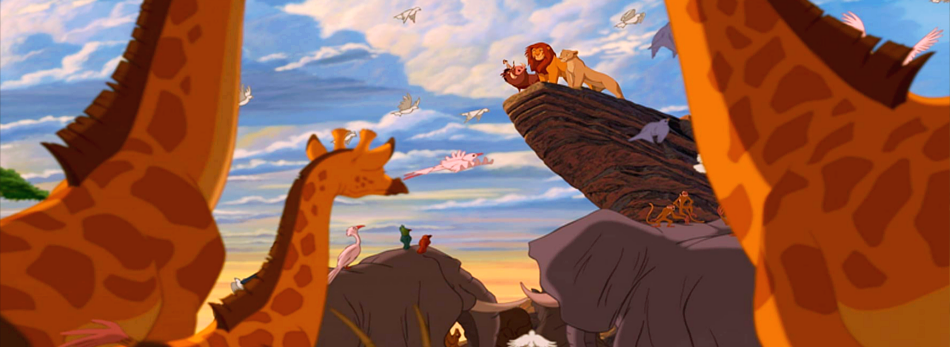 Still image of the characters on the ledge Pumbaa, Timon, Simba and Nala in ?The Lion King?.
Still image of the characters on the ledge Pumbaa, Timon, Simba and Nala in ?The Lion King?.
To conclude, Roger Allers & Rob Minkoff?s ?The Lion King? is seen as being the last hurrah in the period known as the Disney Renaissance era and the exquisite hand drawn animation technique in this sprawling and ambitious Shakespearean influenced narration that takes place on the African savannah of a good-vs.-evil adventure. Roger Allers and Rob Minkoff create in establishing a visual and emotional grandeur that is animatedly simple and bold with a fluency and stalwart assurance in a parallelism of a live action approach, giving a thrilling sense of immediacy and vivaciousness of a thumping coming-of-age tuneful adventure in this stunning, lively, comical, fervent and alluring animal kingdom experience in the climatic Disney Renaissance of cinematically animated masterstroke.
NOTE: The article contains sources from IMDb and Wikipedia.
Follow me and check out other articles of mine:
